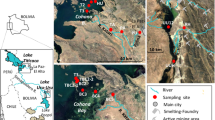Abstract
The Rush Mining District along the Buffalo River in Arkansas has a significant history of zinc and lead mining operations. The tails and spoils of these operations deposit heavy amounts of raw ore into streams. One element commonly found in the earth’s crust that becomes a minor constituent of the deposition is cadmium. Periphyton samples from Rush Creek and Clabber Creek, two creeks within the Rush Mining District were measured for cadmium as well as two creeks with no history of mining, Spring Creek and Water Creek. Periphyton samples from Rush and Clabber Creek contained mean cadmium concentrations of 436.6 ± 67.3 and 93.38 ± 8.67 µg/kg, respectively. Spring Creek and Water Creek had a mean cadmium concentration of 40.49 ± 3.40 and 41.78 ± 3.99 µg/kg within periphyton. The results indicate increased metal concentrations in algal communities from mined areas. As periphyton is the base of the aquatic food chain, it acts as a conduit for movement of cadmium in the food web.



Similar content being viewed by others
References
Adams GI (1904) Zinc and lead deposits of Northern Arkansas. United States Geological Survey, Professional Paper 24, Washington, D.C.: Government Printing Office
Berry E (1977) Mining and mines. In: History of Marion County. Marion County Historical Association, International Graphics Industry, Little Rock, AR, pp 461–471
Bradac P, Behra R, Sigg L (2009) Accumulation of cadmium in periphyton under various freshwater speciation conditions. Environ Sci Technol 43(19):7291–7296. doi:10.1021/es9013536
Chetelat J, Pick FR, Morin A, Hamilton PB (1999) Periphyton biomass and community composition in rivers of different nutrient status. Can J Fish Aquat Sci 56(4):560–569
Cresswell T, Simpson SL, Mazumder D, Callaghan PD, Nguyen AP (2015) Bioaccumulation kinetics and organ distribution of cadmium and zinc in the freshwater decapod crustacean Macrobrachium australiense. Environ Sci Technol 49(2):1182–1189
Cummins KW, Klug MJ (1979) Feeding ecology of stream invertebrates. Annu Rev Ecol Syst 10:147–172. http://www.jstor.org/stable/2096788?seq=1#page_scan_tab_contents
Cummins KW, Merritt RW, Andrade PCN (2005) The use of invertebrate functional groups to characterize ecosystem attributes in selected streams and rivers in south Brazil. Stud Neotrop Fauna Environ 40(1):69–89
Dick D, Philipp E, Kriews M, Abele D (2007) Is the umbo matrix of bivalve shells (Laternula elliptica) a climate archive. Aquat Toxicol 84(4):450–456
Environmental Health and Medicine Education (2008) Cadmium (Cd) toxicity: where is cadmium found. http://www.atsdr.cdc.gov/csem/csem.asp?csem=6&po=4. Accessed 02 Jan 2015
Jarup L (2003) Hazards of heavy metal contamination. Br Med Bull 68(1):167–182
Kotz L, Kaiser G, Tschopel P, Tolg Z (1972) Decomposition of biological materials for the determination of extremely low contents of trace elements in limited amounts with nitric acid under pressure in a teflon tube. Anal Chem 260:207–209
Lide DR (1998) Handbook of chemistry and physics, 87th edn. CRC Press, Boca Raton, pp 4–67 (1363)
Matthews MW, Usrey F, Hodges SW, Harris JL, Christian AD (2009) Species richness, distribution, and relative abundance of freshwater mussels (Bivalvia: Unionidae) of the Buffalo National River, Arkansas. J Ark Acad Sci 63:113–130
Mcknight ET (1935) Zinc and lead deposits of Northern Arkansas. USGS, bulletin 853. Government Printing Office, Washington DC
Mining Web Map (2015) Mining Web Map. Arkansas Geological Survey, n.d. Web. Accessed 22 Mar 2015
Minshall GW, Brock JT, LaPoint TW (1982) Characterization and dynamics of benthic organic matter and invertebrate functional feeding group relationships in the upper Salmon River, Idaho(USA). Int Rev Gesamten Hydrobiol 67(6):793–820
Occupational Safety and Health Administration (2003) Cadmium. U.S. Department of Labor. https://www.osha.gov/SLTC/cadmium/. Accessed 02 Jan 2015
Pitcaithley D (1978) Zinc and lead mining along the Buffalo River. Ark Hist Q 37(4):293–305
Poff NL, Carlisle DM, Moulton SR, Koski ML, Kondratieff BC (2006a) A database of lotic invertebrate traits for North America. US Geological Survey, Reston
Poff NL, Olden JD, Vieira NK, Finn DS, Simmons MP, Kondratieff BC (2006b) Functional trait niches of North American lotic insects: traits-based ecological applications in light of phylogenetic relationships. J North Am Benthol Soc 25(4):730–755
Qu CS, Ma ZW, Yang J, Liu Y, Bi J, Huang L (2012) Human exposure pathway of heavy metals in a lead-zinc mining area, Jiangsu Province, China. PLoS ONE. doi:10.1371/journal.pone.0046793
Rainbow PS (2003) Erratum to trace metal concentrations in aquatic invertebrates: why and so what. Environ Pollut 121:489
Stevenson RJ, Bahls LL (1995) Rapid bioassessment protocols for use in streams and wadeable rivers: periphyton, benthic macroinvertebrates, and fish, 2nd edn. USEPA
Stewart TJ, Behra R, Sigg L (2015) Impact of chronic lead exposure on metal distribution and biological effects to periphyton. Environ Sci Technol 49(8):5044–5051
Tang W, Cui J, Shan B, Wang C, Zhang W (2014) Heavy metal accumulation by periphyton is related to eutrophication in the Hai River Basin, Northern China. PLoS ONE 9(1):e86458
USEPA Method 3050B (1996) Acid digestion of sediments, sludges and soils. http://www.epa.gov/waste/hazard/testmethods/sw846/pdfs/3050b.pdf. Accessed Nov 2014
World Health Organization (2010) Ten chemicals of major public health concern. http://www.who.int/ipcs/assessment/public_health/cadmium/en/. Accessed 02 Jan 2015
Acknowledgments
This study was made possible with support from Arkansas State University, the A-State Ecotoxicology Research Facility, University of Arkansas Division of Agriculture, and the National Park Service. Special thanks to Katelyenn McCauley, Alex Gurley, Cole Harken, Shelby Chappell and Chris Thigpen for their assistance in field and lab work. A special thanks goes to Faron Usery, Chuck Bitting, and Shawn Hodges for their enthusiasm and wisdom provided in development of this project.
Author information
Authors and Affiliations
Corresponding author
Rights and permissions
About this article
Cite this article
McCauley, J.R., Bouldin, J.L. Cadmium Accumulation in Periphyton from an Abandoned Mining District in the Buffalo National River, Arkansas. Bull Environ Contam Toxicol 96, 757–761 (2016). https://doi.org/10.1007/s00128-016-1813-8
Received:
Accepted:
Published:
Issue Date:
DOI: https://doi.org/10.1007/s00128-016-1813-8




